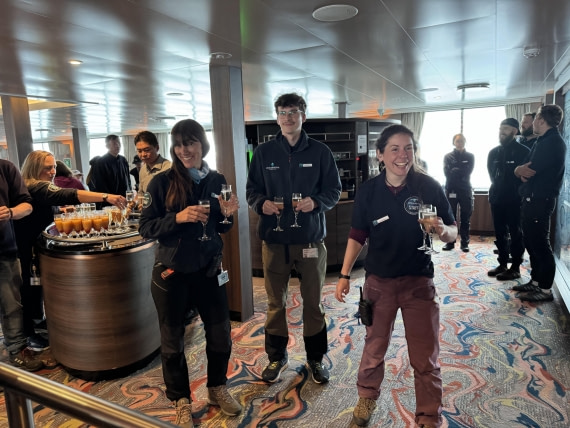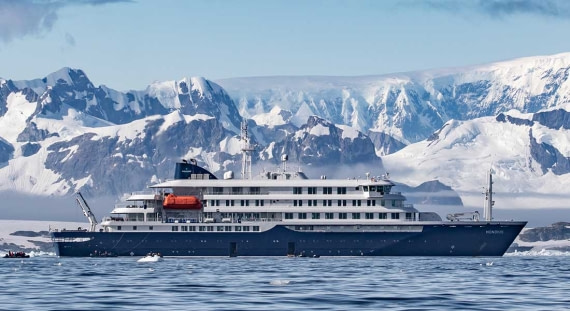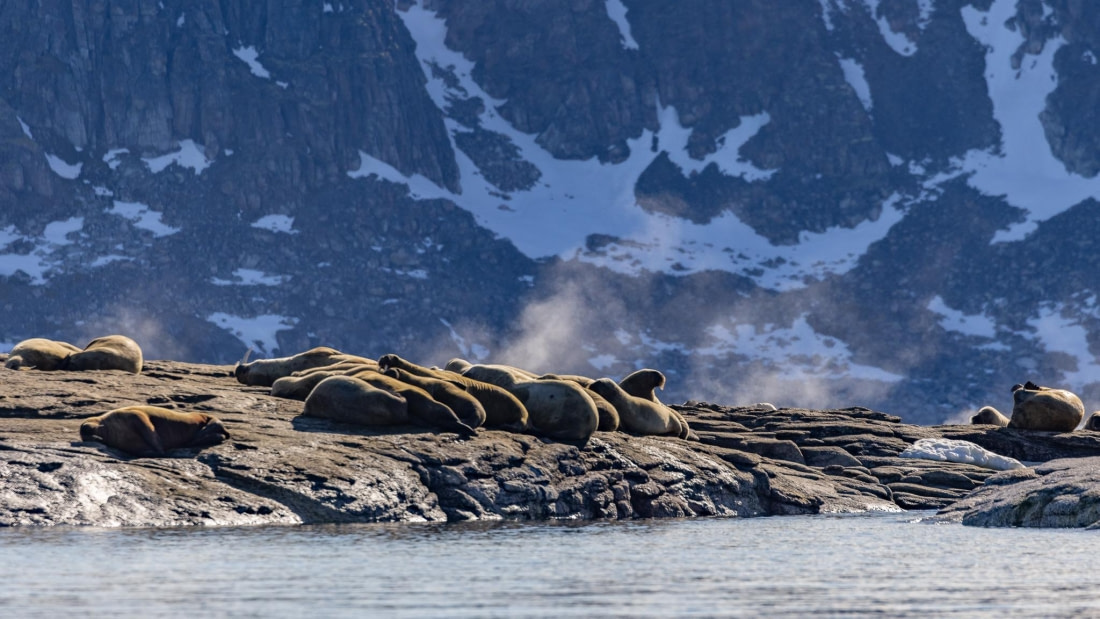| Datum: |
05.07.2024 |
| Position: |
79°36.5'N 012°43.8'E |
| Wind: |
N-4 |
| Wetter: |
Bewölkung/Regen |
| Lufttemperatur: |
+2 |
Glattes Wasser und Nebel erwarteten uns am Eingang des Liefdefjorden auf dem Weg zu unserem ersten, wirklich expeditionsähnlichen Tag.
Auf der Brücke entdeckte eine Gruppe frühmorgendlicher Späher einen Eisbären, der auf der kleinen Inselgruppe der Andøyane umherstreifte. Der Bär plünderte Gänsenester auf der Suche nach proteinhaltigen Eiern. Sofort weckte uns Expeditionsleiter Marcel mit der guten Nachricht, und Kapitän Artur steuerte das Schiff so, dass wir vom Bug und den Außendecks aus einen guten Blick auf den Bären hatten, auch wenn wir wegen des Vogelschutzgebiets Andøyane nur eine relativ weite Sicht hatten. Ein Zodiac mit zwei Führern wurde zu unserer Sicherheit ins Wasser gelassen, für den Fall, dass der Bär beschlossen hätte, zur Texas Bar zu schwimmen, unserem morgendlichen Landeplatz.
Die Hondius segelte weiter, während das Frühstück serviert wurde, und wir gingen schließlich an der nordwestlichen Ecke des Fjords von Bord. Der Liefdefjord ist ein 30 km langer Fjord, der west-südwestlich vom Woodfjord abzweigt. Benannt nach einer holländischen Barke aus dem XVII. Jahrhundert, der Liefde "Liebe", empfing er uns mit einer wunderschönen bergigen und vergletscherten Landschaft. Wir stiegen in die Zodiacs und wurden in der Nähe einer alten Trapperhütte, die "Texas Bar" getauft wurde, an Land gebracht. Hier teilten wir uns in Gruppen auf und unternahmen lange, mittlere und kurze Wanderungen an den steilen und felsigen Hängen der Bucht.
Obwohl der Tag recht düster war, war das Gelände mit farbenfrohen Blumen übersät: violette Saxifrages, Weißgräser, Berg-Avens und Spitzmohn führten uns in die bunte Welt der arktischen Tundra ein. Findlinge und Gletschermoränen erzählten uns von der langen Geschichte der Vergletscherung Spitzbergens, und nachdem sich die Gruppen in der Nähe der Küste versammelt hatten, wurde der klassische Polartauchgang durchgeführt.
Zur Mittagszeit wurde die Hondius kurz umpositioniert und fuhr tiefer in den Liefdefjorden hinein, direkt vor den beeindruckendsten Gezeitengletscher der Region: Monacobreen. Dieser gewaltige, 4,5 km breite und 22 km lange Eisfluss fließt von der Nordseite des Isachsenfonna-Eisfelds herab und kalbt in den Fjord, was zu einer großen Vielfalt an Arten und Farben kleiner bis mittelgroßer Eisberge führt. Die Expeditionsleiter fuhren uns auf einer herrlichen Zodiac-Kreuzfahrt gut zwei Stunden lang um die Bucht herum, bevor der kalte Wind und der leichte Schnee uns zwangen, uns in die Wärme der Hondius-Lounge zurückzuziehen. Die Szenerie auf dem Wasser war überwältigend, umgeben von spritzigen, schimmernden Bergspitzen beobachteten wir Küstenseeschwalben, Graubauch-Seeschwalben und ein paar arktische Skuas, die über unseren Köpfen schwebten, während donnernde Kalbungen von der 50 bis 60 m hohen Front des Monacobreen uns mahnten, einen sicheren Abstand zu halten.
Bei der abendlichen Zusammenfassung sprach Marco über Informationen zur Gletscherbildung und -dynamik, wobei wir etwas über das Schwankungsverhalten des Monaco-Gletschers erfuhren, abgerundet durch Simons lustige Fakten über die Küstenseeschwalbe. Gleich nach dem Abendessen wurde der 80. Breitengrad über die Lautsprecheranlage verkündet, und die Sandinsel Moffen mit zahlreichen Walrossen tauchte am Horizont im Nebel auf.
Was für ein Tag voller Aktivitäten und Aufregung in der nordwestlichen Ecke des Svalbard-Archipels!
Regelmäßige Kajakgruppe 5. Juli
Heute war unsere erste Gelegenheit zum Paddeln. Texas Bar bietet einen guten Einstieg, da es geschützte Lagunen gibt, in denen wir unser Kajak vom Zodiac aus zu Wasser lassen und ein paar Paddelschläge üben konnten. Es war heute ziemlich kalt, und wir sollten alle Mützen, Handschuhe, Ersatzpullis usw. mitbringen, aber wir waren gut geschützt, und später am Morgen fielen nur ein paar Schneeflocken.
Nachdem wir gelernt hatten, wie man als Tandem steuert, und mit vielen Ratschlägen, wie man zusammenbleibt, bogen wir aus dem Hornbaekpollen ab, um ein paar hundert Meter die Küste hinaufzufahren und überraschten dabei einige Kurzschnabelgänse und Gänseküken. Als wir uns entfernten, genossen wir den Anblick der Elternvögel, die ihre Jungen dazu aufforderten, von den Felsen ins Wasser zu springen. Dann drehten wir ab und fuhren in nordöstlicher Richtung unter den Vogelfelsen hindurch, wo Weißwangengänse nisteten, und landeten am Strand von Texas Bar, wo der Großteil des Kajakteams zum Polartauchen anhielt, während die Kajaks zum Schiff zurückgebracht wurden!
































